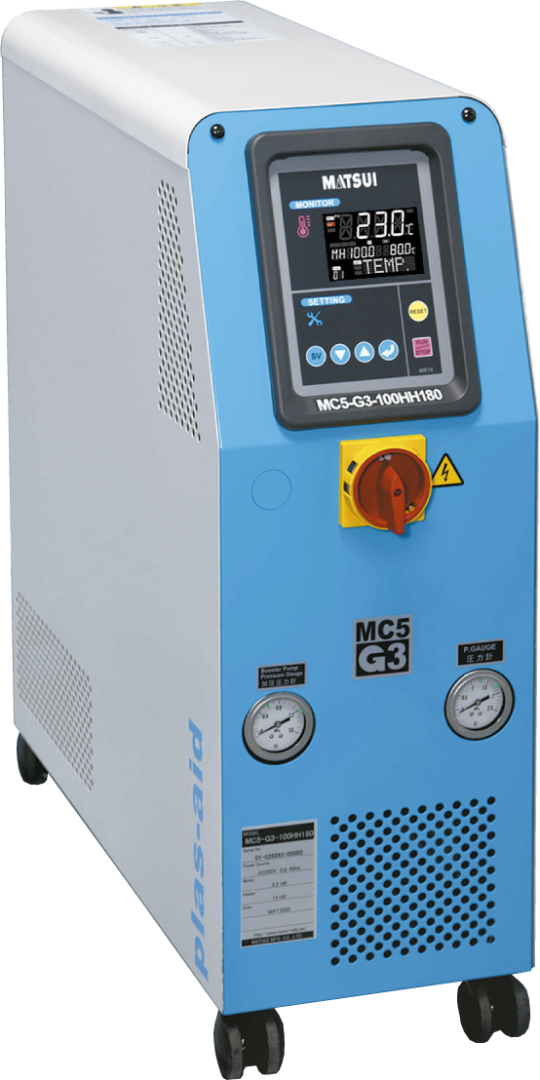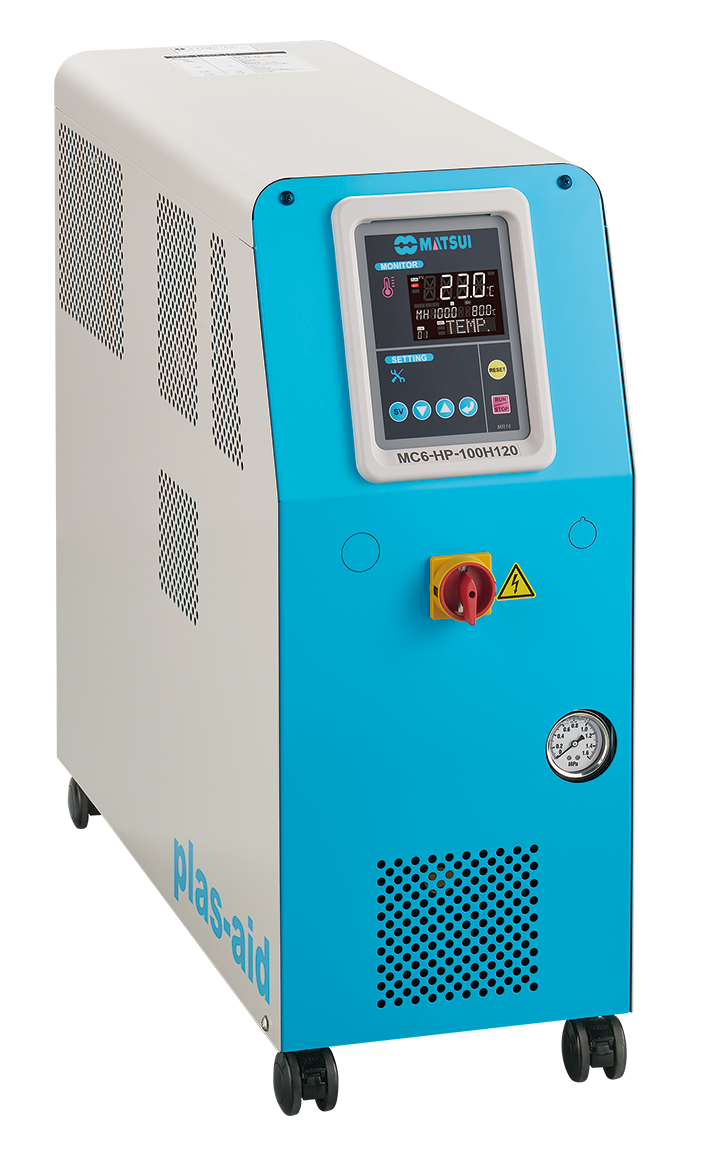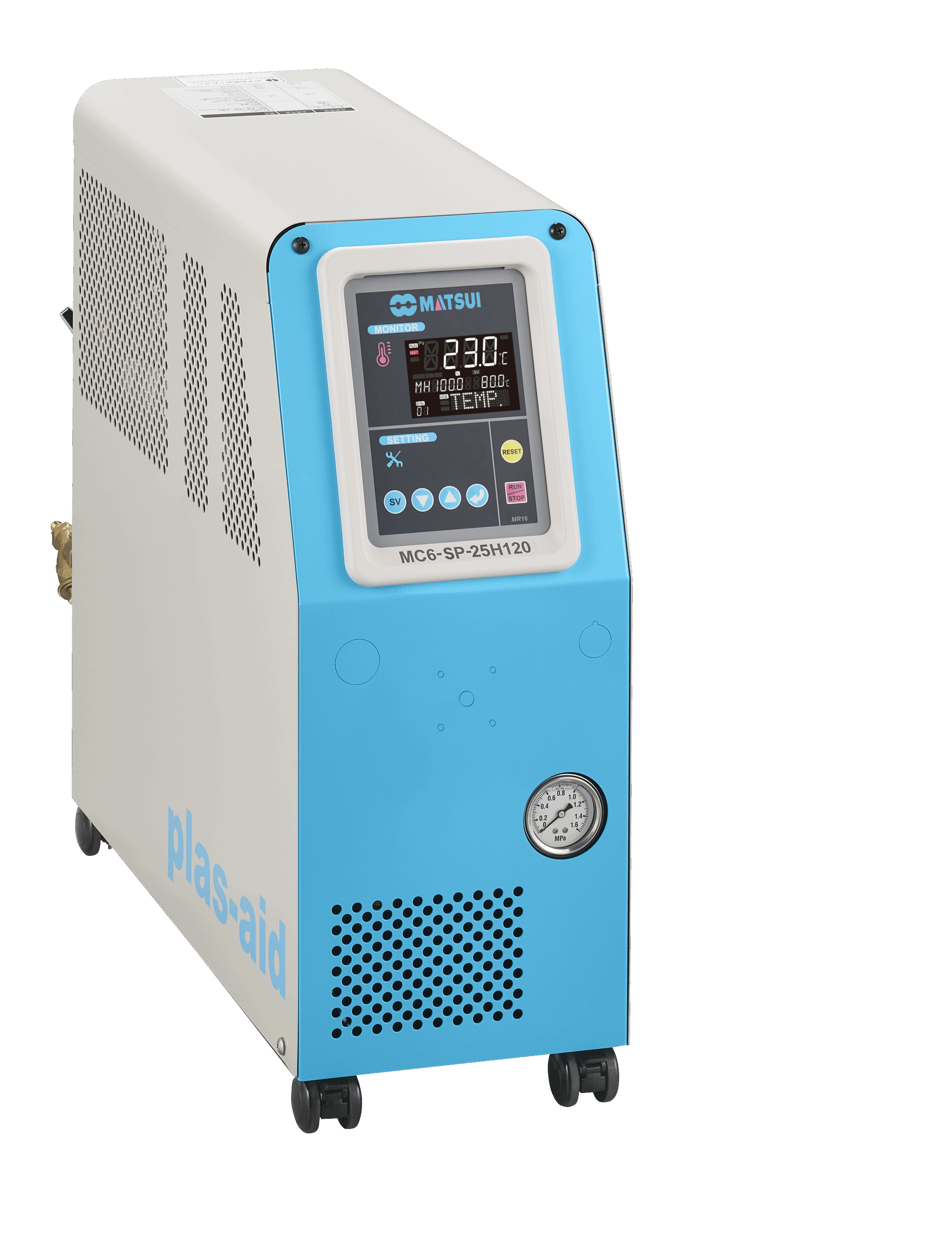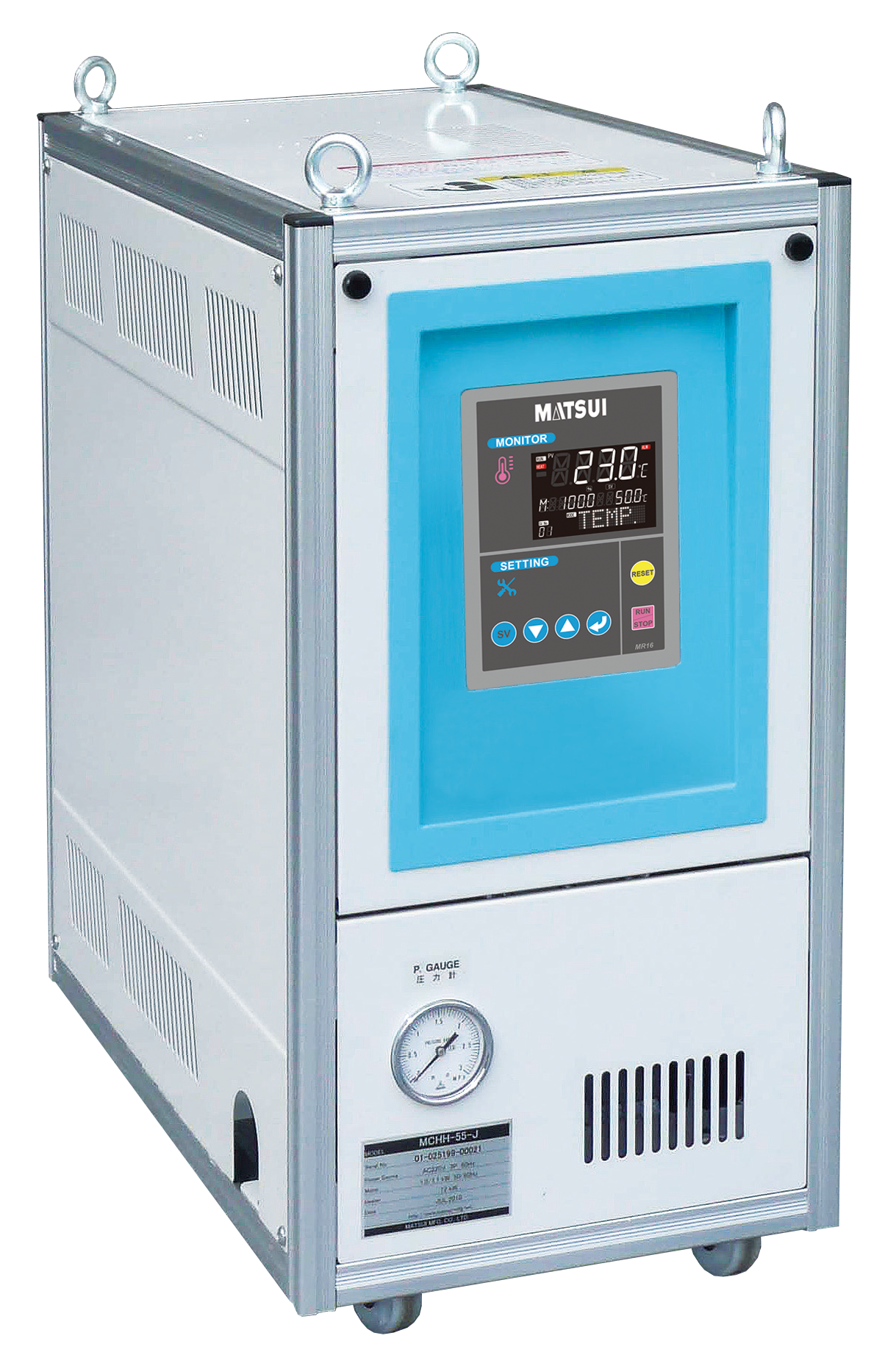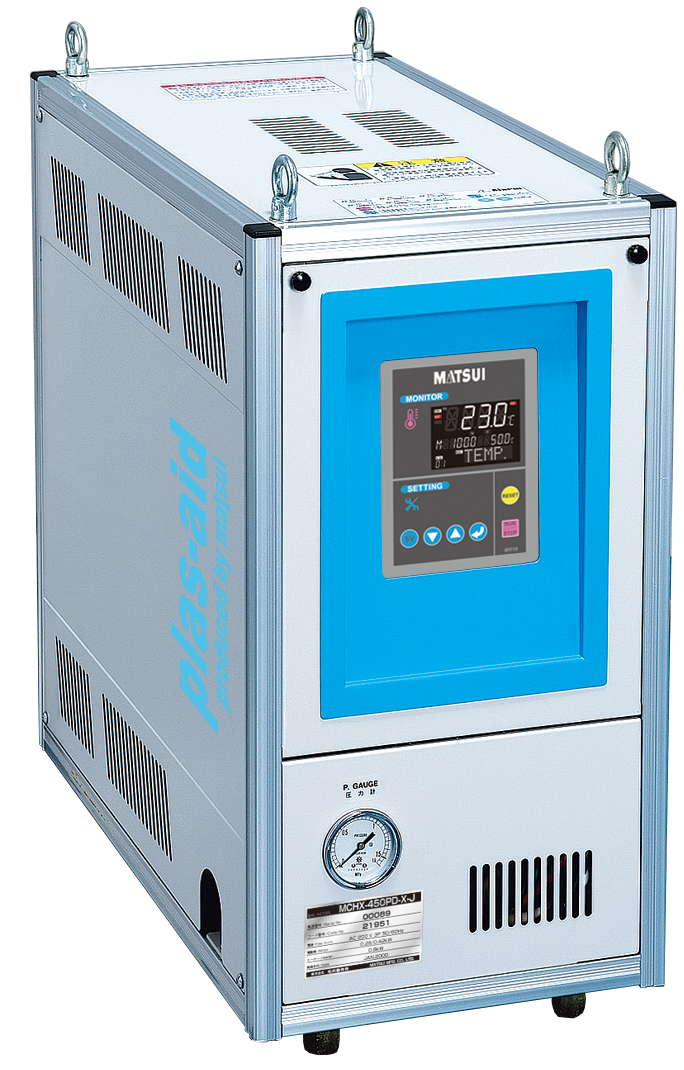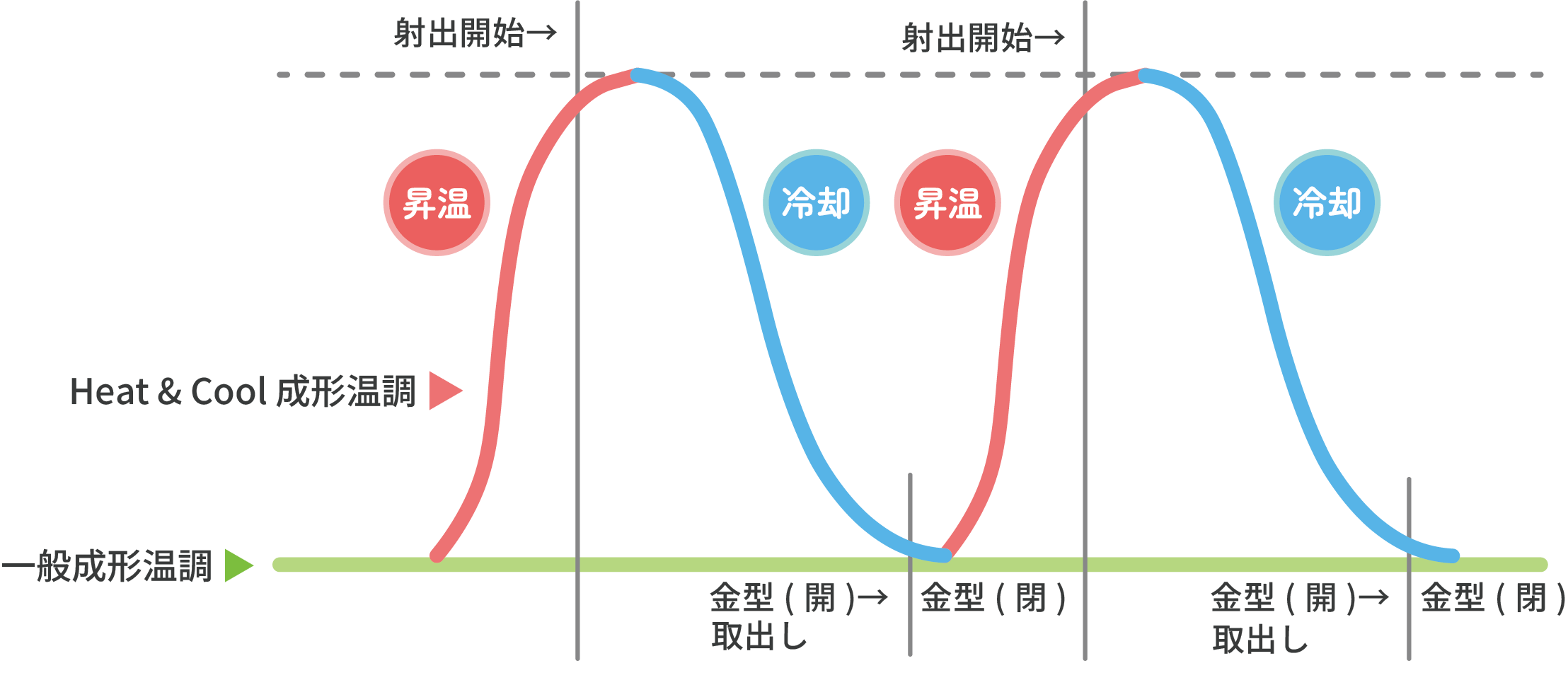In recent years, polyphenylene sulfide (PPS) is one of the high-performance resins that has been attracting attention in the market. In addition to excellent chemical resistance, corrosion resistance, and dimensional stability, it also has good fluidity during molding, and its use is expanding in the electrical and electronic parts and automotive fields against the backdrop of the need to reduce weight and replace metals.
During molding, the mold temperature is generally set to around 120-150°C. By promoting crystallization in this temperature range, it is possible to maximize the inherent heat-resistant resistance, mechanical strength, chemical resistance, and dimensional stability of PPS. However, care must be taken as a mold temperature that is too high increases the risk of flashing.
For stable molding, it is important to select Mold Temperature Controller that can provide appropriate temperature control.

Features
1. Matsui's unique indirect cooling method solves problems caused by pressure loss!
Improved flow of cooling water for heat exchangers
In conventional indirect cooling systems, the cooling water is branched off from the discharge side of the booster pump and sent to the heat exchanger. Therefore, during cooling (when Cooling water solenoid valve is open), the pressure in the system, which is pressurized by the booster pump, drops due to the resistance caused by the branching of the cooling water. As a result, if the pressure in the system falls below the saturated vapor pressure, there is a risk that the temperature control medium will boil.
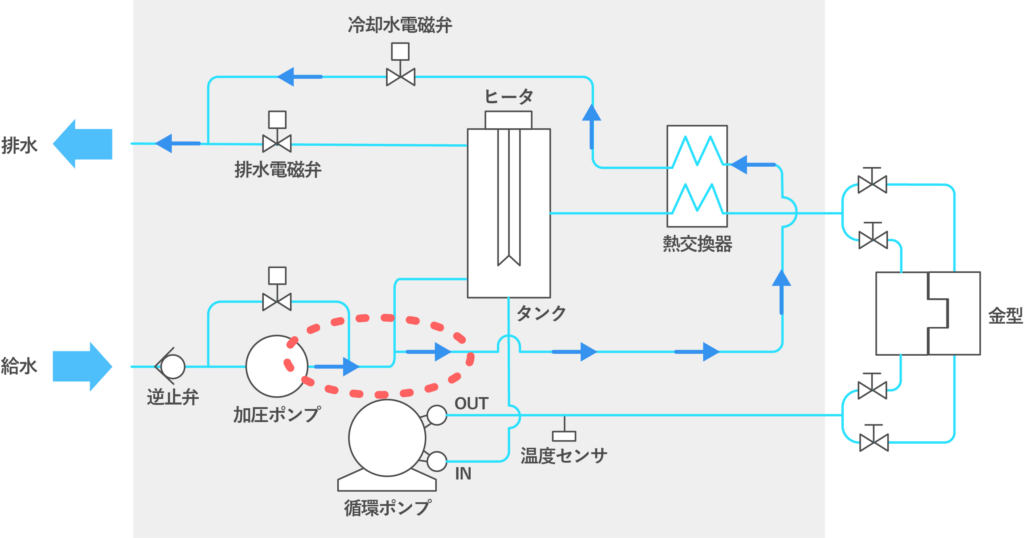
Therefore, in the MC5-HH, the flow was improved so that the supplied cooling water is branched just before the booster pump and supplied to the heat exchanger. This means that the cooling water is sent to the heat exchanger without passing through the booster pump, improving the pressure resistance on the discharge side, stabilizing the pressure of the temperature control medium even during cooling, and eliminating problems caused by boiling.
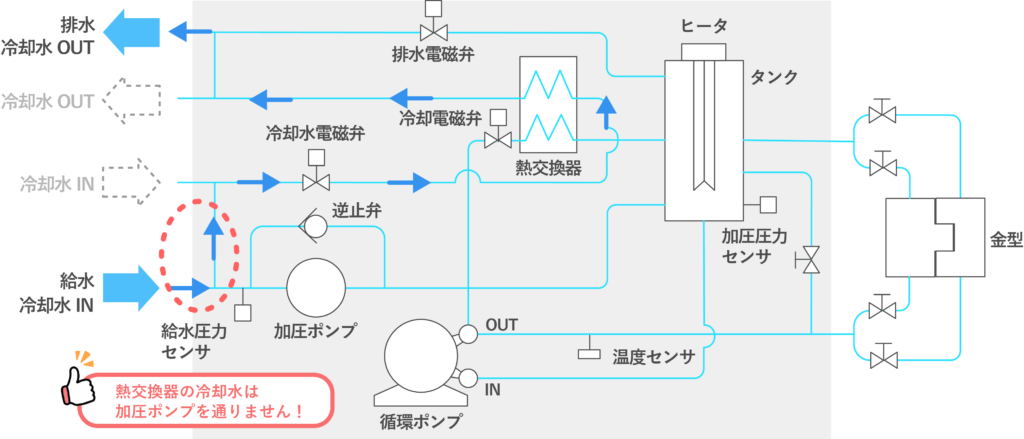
Improved flow of temperature control medium through the mold
In conventional indirect cooling methods, the temperature control medium returning from the mold is constantly passed through a heat exchanger. However, the temperature control medium experiences pressure loss when passing through the heat exchanger, which can limit the flow rate.
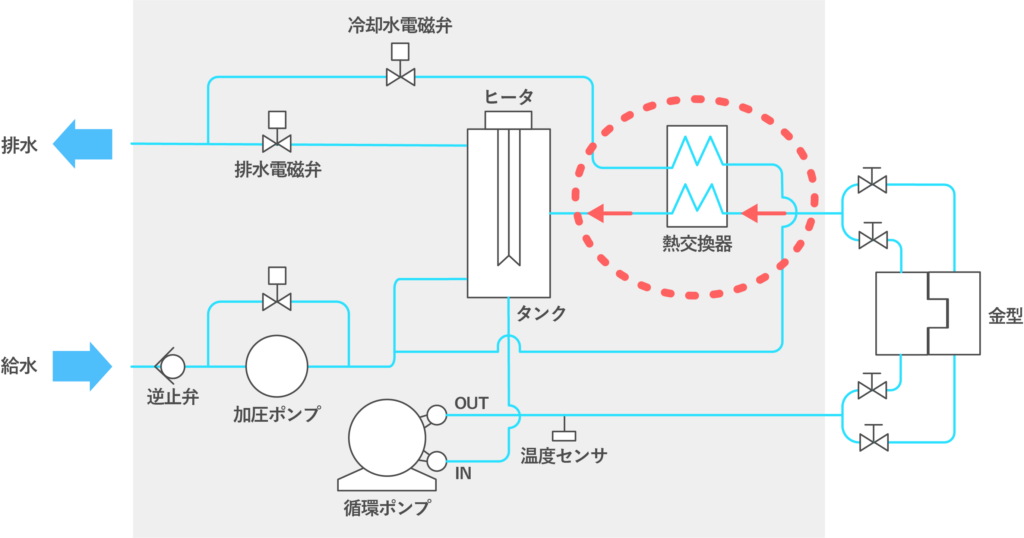
Therefore, in the MC5-HH, the temperature control medium is branched off from the discharge side of the circulation pump, and the flow is improved so that it passes through the heat exchanger only during cooling. The temperature control medium that returns from the mold is sent directly to the tank. By not connecting a heat exchanger to the circulation path, pressure loss has been reduced, and the flow rate of the temperature control medium has been improved compared to conventional methods.
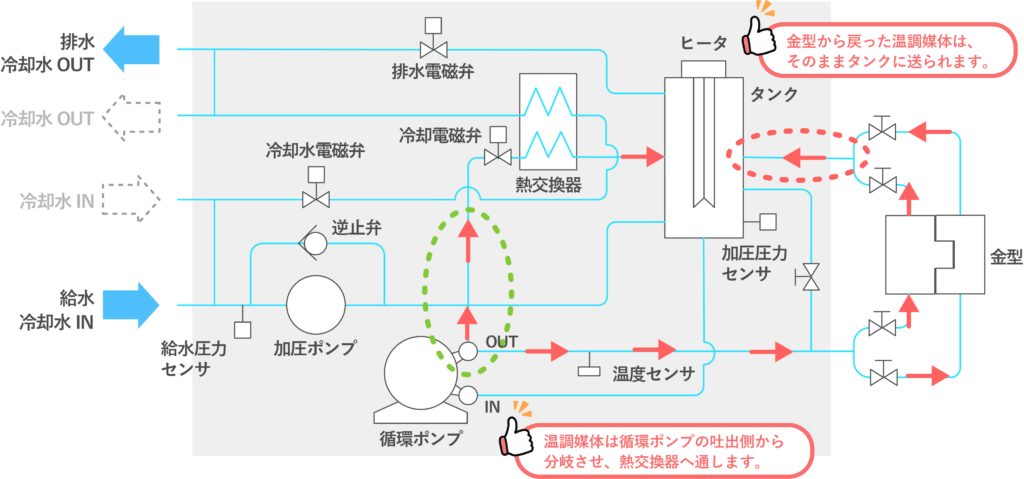

What if we had to branch off the cooling water from the circulation pump and send it to the mold and heat exchanger?
Is the cooling water flow rate being properly sent to the mold?

Because the diameter of the pipes on the mold side is larger than that on the heat exchanger side, most of the temperature control medium naturally flows to the mold. Therefore, there is no need to worry about the flow rate being reduced to such an extent that it affects temperature control.

Even though most of the temperature control medium flows toward the mold, is it possible to lower the temperature properly?

First, the temperature of the medium is compared with the set temperature, and the temperature is adjusted by switching between heating control and cooling control. When the temperature of the medium is lower than the set temperature, it is heated by a heater, and when it is higher, the cooling solenoid valve is opened to cool part of it, so the temperature can be adjusted accurately without lowering it too much.
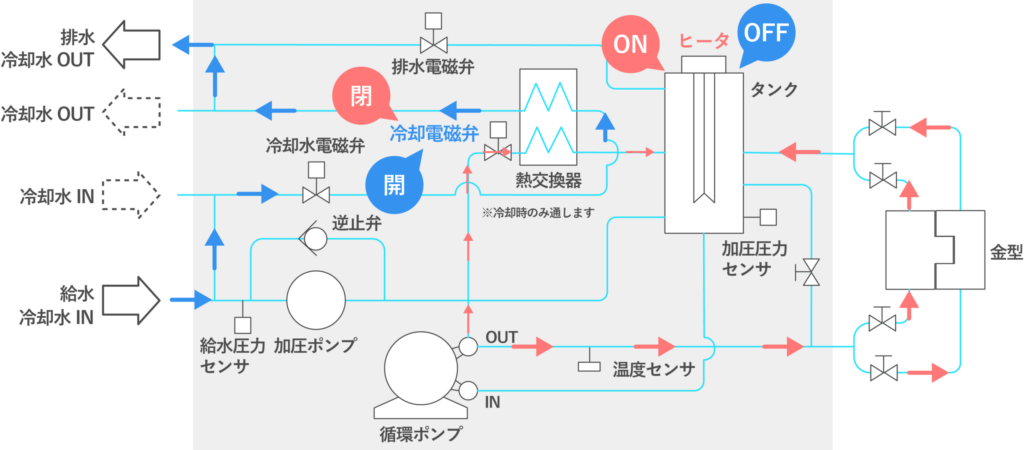
Changed the flow of Cooling water solenoid valve to improve cooling operation
In conventional indirect cooling systems, the cooling action was controlled by a cooling solenoid valve on the cooling water side of the heat exchanger. Therefore, when cooling (when Cooling water solenoid valve is open), the pressure in the piping drops, causing the cooling water in the heat exchanger to evaporate, which can lead to the accumulation of scale.
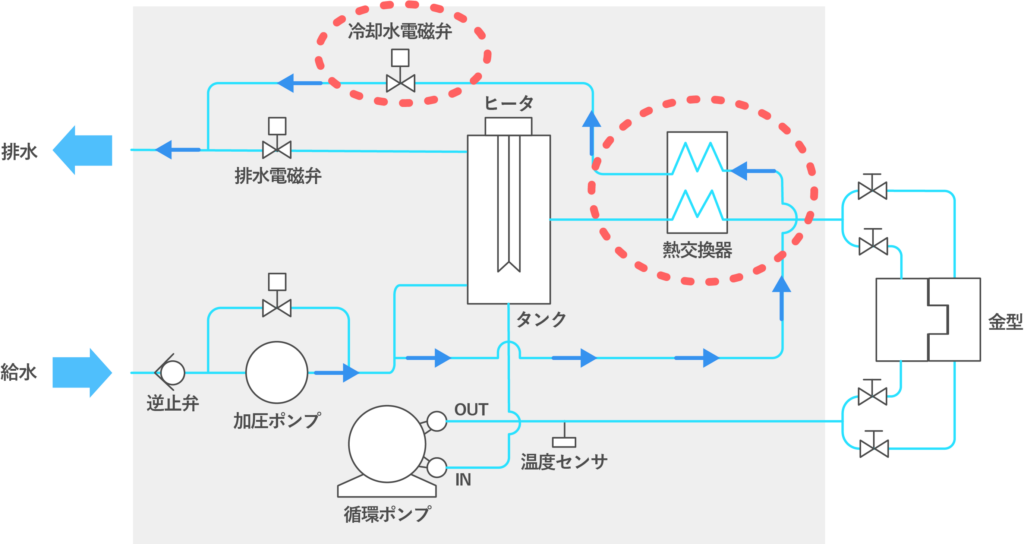
Therefore, in the MC5-HH, when the medium temperature is over 100°C, the cooling water for the heat exchanger is always flowing. When the medium temperature is higher than the set temperature, the cooling solenoid valve is opened and some of the temperature control medium is passed through the heat exchanger to be cooled.
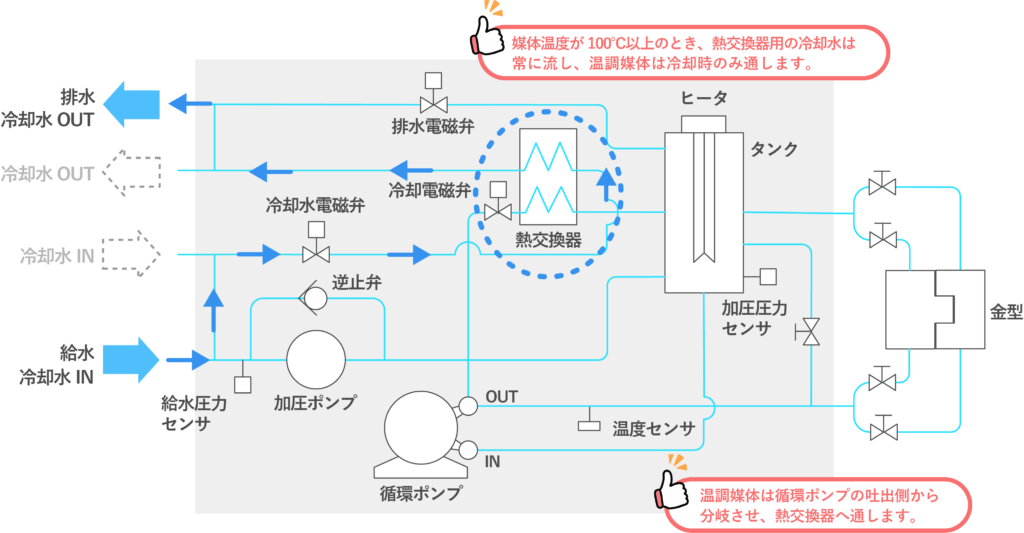

Isn't it a waste to keep the cooling water flowing through the heat exchanger all the time?

To keep the heat exchanger cool at all times, the stationary temperature control medium is cooled during heating control, so when it's time to cool it down, it's ready at a lower temperature!

I see. So when the cooling solenoid valve opens, there's no need to take the time to cool the heat exchanger. And since the temperature control medium is properly prepared for cooling, it looks like the cooling can be controlled smoothly.
2. Matsui's unique pressure control achieves energy and labor savings!
Energy saving by applying pressure only when necessary
The booster pump is automatically controlled to maintain the saturated vapor pressure or higher according to the medium temperature detected by the temperature sensor. By applying only the necessary amount of pressure when needed, efficient operation is achieved without waste. Furthermore, the booster pump (piston pump) used in the MC5-HH can maintain a stable pressure in the system without constantly running, so there is no need to worry about pressure drops due to pump stoppages.
Labor-saving operation with automatic pressure adjustment
By automatically adjusting the pressure of the booster pump, the pressure in the system is always kept at an appropriate level without the need for manual operation. This prevents pressure adjustment errors caused by fluctuations in the water supply pressure, and eliminates the risk of the temperature control medium boiling if the pressure in the system falls below the saturated vapor pressure, or conversely, the pressure becoming too high and causing equipment failure.

What happens if the pressure in the system gets too high?
During the temperature rise, the pressure in the system increases due to the thermal expansion of the medium. If the pressure exceeds the set pressure, the drain solenoid valve opens to reduce the pressure, adjusting the pressure appropriately before the safety valve operates.
3. Removing air bubbles from the system also solves problems caused by cavitation!
Remove air bubbles by repeatedly turning the circulation pump on and off.
When draining the water from the hose connecting the mold and Mold Temperature Controller during mold replacement, maintenance, or hose replacement, air may get in. If these air bubbles cause cavitation inside the pump, it can reduce Discharge amount and cause vibration and noise, which may lead to pump failure. Therefore, the MC5-HH uses a mechanism that thoroughly removes air bubbles by repeatedly turning the circulation pump on and off after supplying water to the tank.

Wait, what do you mean by turning the pump on and off repeatedly to remove air bubbles?

In fact, the pump movement is used effectively to perform air venting and media blowing.
First, turn the pump on and off several times to send air bubbles into the tank along with the circulating medium, then turn the pump off to stop the flow of medium, and the light air bubbles will naturally collect at the top of the tank.
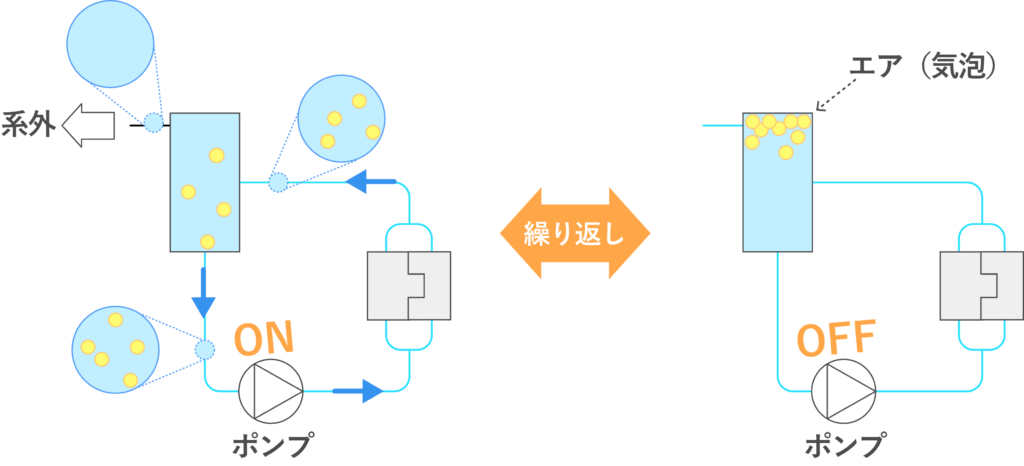
Finally, the pump is turned on all the time to flush the air bubbles out of the system along with the overflowing medium.
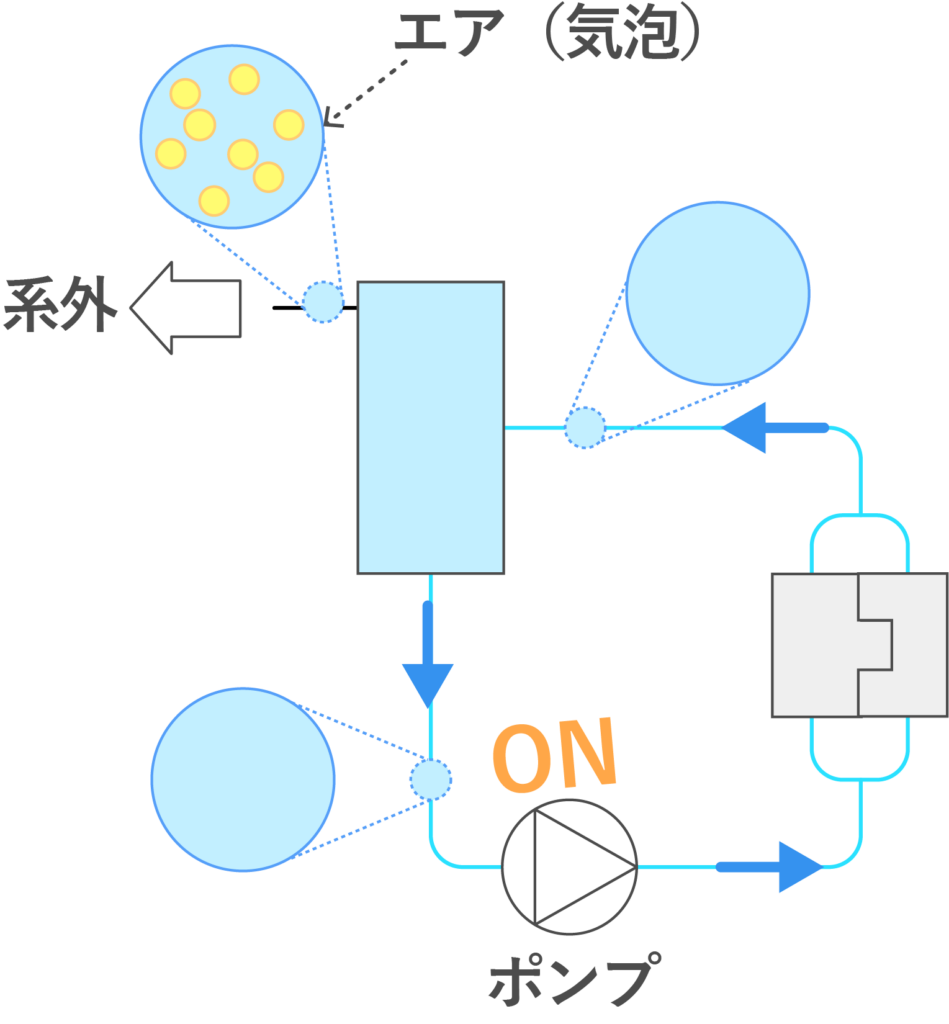

Ah, I see. The pump runs to collect the air bubbles in the tank, and then they are all released outside at the end!

Yes, that's right. By doing this, you can remove any air bubbles and operate the pump safely.
What is saturated vapor pressure?
Whether a substance remains a liquid or turns into a gas (vapor) is determined by the balance of temperature and pressure at the time.
The pressure at which a substance tries to change from liquid to gas at a certain temperature is called "saturated vapor pressure." This saturated vapor pressure increases as the temperature rises, and different values are determined for each substance. For example, in the case of water, at 100°C the saturated vapor pressure is approximately 0.1 MPa (megapascals), at which point boiling begins. By utilizing this relationship and maintaining a balance between temperature and pressure, it is possible to maintain a stable state in liquids without boiling.
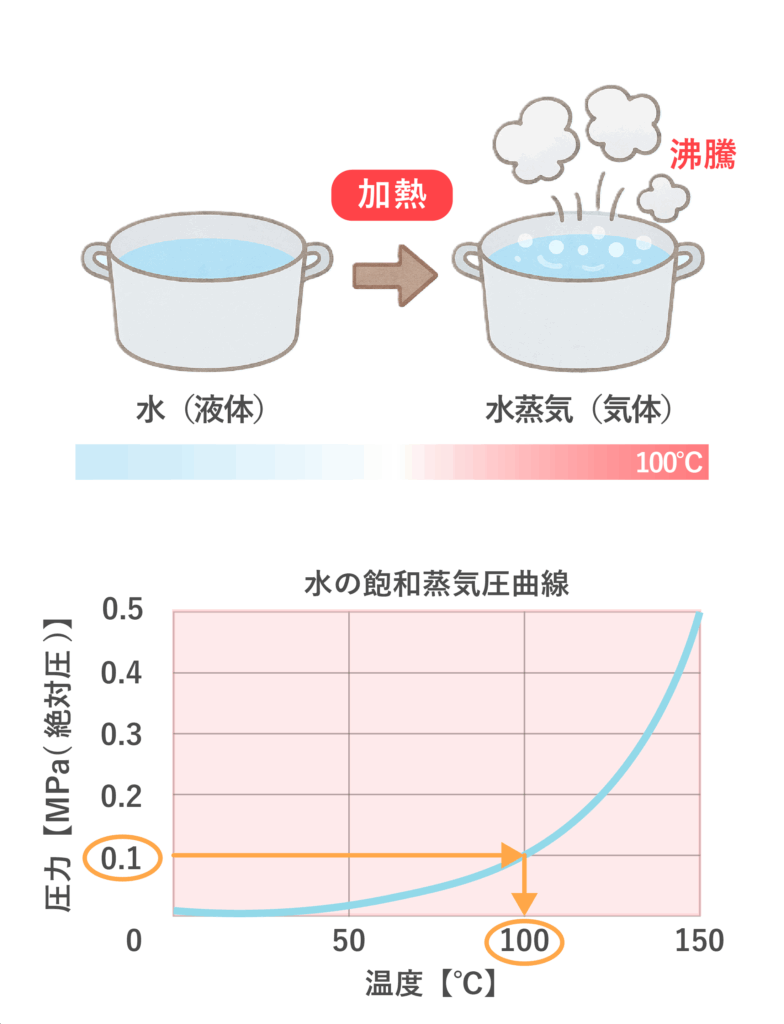

The required pressure is determined by the high Temperature controllers.

To circulate the water to the mold without boiling it, the pressure within the system must be kept above the saturated vapor pressure at that time.
However, in normal facilities, the water supply pressure is generally around 0.2 to 0.4 MPa (gauge pressure).
Therefore, the MC5-HH realizes stable pressure control by calculating the required pressure inside the tank from the medium temperature and using a pressure pump to make up for any deficiency.

